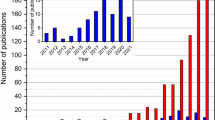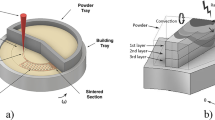Abstract
A mesoscopic model has been established to investigate the thermodynamic mechanisms and densification behavior of nickel-based superalloy during additive manufacturing/three-dimensional (3D) printing (AM/3DP) by numerical simulation, using a finite volume method (FVM). The influence of the applied linear energy density (LED) on dimensions of the molten pool, thermodynamic mechanisms within the pool, bubbles migration and resultant densification behavior of AM/3DP-processed superalloy has been discussed. It reveals that the center of the molten pool slightly shifts with a lagging of 4 μm towards the center of the moving laser beam. The Marangoni convection, which has various flow patterns, plays a crucial role in intensifying the convective heat and mass transfer, which is responsible for the bubbles migration and densification behavior of AM/3DP-processed parts. At an optimized LED of 221.5 J/m, the outward convection favors the numerous bubbles to escape from the molten pool easily and the resultant considerably high relative density of 98.9 % is achieved. However, as the applied LED further increases over 249.5 J/m, the convection pattern is apparently intensified with the formation of vortexes and the bubbles tend to be entrapped by the rotating flow within the molten pool, resulting in a large amount of residual porosity and a sharp reduction in densification of the superalloy. The change rules of the relative density and the corresponding distribution of porosity obtained by experiments are in accordance with the simulation results.











Similar content being viewed by others
References
Chen Y, Zhang K, Huang J et al (2016) Characterization of heat affected zone liquation cracking in laser additive manufacturing of Inconel 718. Mater Des 90:586–594
Liu YG, Zhang CP, Liu CF et al (2016) The effect of nitrogen annealing on lithium ion intercalation in nickel-doped lithium trivanadate. Sci Bull 61:587–593
Zhao Y, Zhang HY, Wei H et al (2014) Progress of phase-field investigations of CO rafting in nickel-base single-crystal superalloys. Chin Sci Bull 59:1684–1695
Kuo CM, Yang YT, Bor HY et al (2009) Aging effects on the microstructure and creep behavior of Inconel 718 superalloy. Mater Sci Eng A 510:289–294
Altin A, Nalbant M, Taskesen A (2007) The effects of cutting speed on tool wear and tool life when machining Inconel 718 with ceramic tools. Mater Des 28:2518–2522
Qi H, Azer M, Ritter A et al (2009) Studies of standard heat treatment effects on microstructure and mechanical properties of laser net shape manufactured Inconel 718. Metall Mater Trans A 40:2410–2422
Thakur DG, Ramamoorthy B, Vijayaraghavan L et al (2009) Study on the machinability characteristics of superalloy Inconel 718 during high speed turning. Mater Des 30:1718–1725
Wang ZY, Rajurkar KP, Fan J et al (2003) Hybrid machining of Inconel 718. Int J Mach Tool Manuf 43:1391–1396
Wang Z, Guan K, Gao M et al (2012) The microstructure and mechanical properties of deposited-IN718 by selective laser melting. J Alloys Compd 513:518–523
Cloots M, Uggowitzer PJ, Wegener K et al (2016) Investigations on the microstructure and crack formation of IN738LC samples processed by selective laser melting using Gaussian and doughnut profiles. Mater Design 89:770–784
Marcu T, Todea M, Gligor I et al (2012) Effect of surface conditioning on the flowability of Ti6Al7Nb powder for selective laser melting applications. Appl Surf Sci 258:3276–3282
Zhao XL, Li SJ, Zhang M et al (2016) Comparison of the microstructures and mechanical properties of Ti–6Al–4V fabricated by selective laser melting and electron beam melting. Mater Des 95:21–31
Gu DD, Meiners W, Wissenbach K et al (2012) Laser additive manufacturing of metallic components: materials, processes and mechanisms. Int Mater Rev 57:133–164
Kimura T, Nakamoto T (2016) Microstructures and mechanical properties of A356 (AlSi7Mg0.3) aluminum alloy fabricated by selective laser melting. Mater Des 89:1294–1301
Trosch T, Strößner J, Völkl R et al (2016) Microstructure and mechanical properties of selective laser melted Inconel 718 compared to forging and casting. Mater Lett 164:428–431
Jia QB, Gu DD (2014) Selective laser melting additive manufactured Inconel 718 superalloy parts: high-temperature oxidation property and its mechanisms. Opt Laser Technol 162:161–171
Chlebus E, Gruber K, Kuźnicka B et al (2015) The microstructure and mechanical properties of deposited-IN718 by selective laser melting. Mater Sci Eng A 639:647–655
Amato KN, Gaytan SM, Murr LE et al (2012) Microstructures and mechanical behavior of Inconel 718 fabricated by selective laser melting. Acta Mater 60:2229–2239
Jia QB, Gu DD (2014) Selective laser melting additive manufacturing of Inconel 718 superalloy parts: densification, microstructure and properties. J Alloys Compd 585:713–721
Lu YJ, Wu SQ, Gan YL et al (2015) Study on the microstructure, mechanical property and residual stress of SLM Inconel-718 alloy manufactured by differing island scanning strategy. Opt Laser Technol 75:197–206
Li RD, Shi YS, Wang ZG et al (2010) Densification behavior of gas and water atomized 316L stainless steel powder during selective laser melting. Appl Surf Sci 256:4350–4356
Millett PC, Tonks M (2011) Phase-field simulations of gas density within bubbles in metals under irradiation. Comput Mater Sci 50:2044–2050
Qiu CL, Panwisawas C, Ward M et al (2015) On the role of melt flow into the surface structure and pore development during selective laser melting. Acta Mater 96:72–79
Thijs L, Verhaeghe F, Craeghs T et al (2010) A study of the microstructural evolution during selective laser melting of Ti–6Al–4V. Acta Mater 58:3303–3312
Thijs L, Kempen K, Kruth JP et al (2013) Fine-structured aluminium products with controllable texture by selective laser melting of pre-alloyed AlSi10Mg powder. Acta Mater 61:1809–1819
Du LF, Wang LL, Zheng B et al (2016) Phase-field modeling of microstructure evolution during solidification in presence of gas bubble. Comput Mater Sci 114:94–98
Qiu CL, Adkins NJE, Attallah MM (2013) Microstructure and tensile properties of selectively laser-melted and of HIPed laser-melted Ti–6Al–4V. Mater Sci Eng A 578:230–239
Qiu CL, Yue S, Adkins NJE et al (2015) Influence of processing conditions on strut structure and compressive properties of cellular lattice structures fabricated by selective laser melting. Mater Sci Eng A 628:188–197
Dai DH, Gu DD (2014) Thermal behavior and densification mechanism during selective laser melting of copper matrix composites: simulation and experiments. Mater Des 55:482–491
KhairallahSA AndersonA (2014) Mesoscopic simulation model of selective laser melting of stainless steel powder. J Mater Process Technol 214:2627–2636
MasmoudiA Bolot R, Coddet C (2015) Investigation of the laser-powder-atmosphere interaction zone during the selective laser melting process. J Mater Process Technol 225:122–132
Das S (2003) Physical aspects of process control in selective laser sintering of metals. Adv Eng Mater 10:701–711
Li SZ, Chen R, Wang H et al (2015) Numerical study on solid–liquid phase change in paraffin as phasechange material for battery thermal management. Sci Bull 60:1911–1926
Malgarinos I, Nikolopoulos N, Gavaises M et al (2015) Coupling a local adaptive grid refinement technique with an interface sharpening scheme for the simulation of two-phase flow and free-surface flows using VOF methodology. J Comput Phys 300:732–753
Dai K, Shaw L et al (2005) Finite element analysis of the effect of volume shrinkage during laser densification. Acta Mater 53:4743–4754
Bag S, Trivedi A, De A (2009) Development of a finite element based heat transfer model for conduction mode laser spot welding process using an adaptive volumetric heat source. Int J Therm Sci 48:1923–1931
Foroozmehr A, Badrossamay M, Foroozmehr E et al (2016) Finite element simulation of selective laser melting process considering optical penetration depth of laser in powder. Mater Des 89:255–263
Nie PL, Ojo OA, Li ZG (2014) Modeling analysis of laser cladding of a nickel-based superalloy. Surf Coat Technol 258:1048–1059
Hussein A, Hao L, Yan CZ et al (2013) Finite element simulation of the temperature and stress fields in single layers built without-support in selective laser melting. Mater Des 52:638–647
Yin J, Zhu H, Ke L et al (2012) Simulation of temperature distribution in single metallic powder layer for laser micro-sintering. Comput Mater Sci 53:333–339
Lei YP, Murakawa H, Shi YW et al (2001) Numerical analysis of the competitive influence of Marangoni flow and evaporation on heat surface temperature and molten pool shape in laser surface remelting. Comput Mater Sci 21:276–290
Zhu ZQ, Liu QS (2010) Coupling of thermocapillary convection and evaporation effect in a liquid layer when the evaporating interface is open to air. Chin Sci Bull 55:233–238
Yuan PP, Gu DD (2015) Molten pool behaviour and its physical mechanism during selective laser melting of TiC/AlSi10Mg nanocomposites: simulation and experiments. J Phys D Appl Phys 48:035303–035318
Kulkarni AA, Joshi JB (2005) Bubble formation and bubble rise velocity in gas–liquid systems: a review. Ind Eng Chem Res 44:5873–5931
Zhang XB, **ang SJ, Cao XL et al (2011) Effects of surface tension on bubble growth in an extensive uniformly superheated liquid. Chin Sci Bull 56:3191–3198
Acknowledgments
This work was supported by the National Natural Science Foundation of China (51575267, 51322509), the Top-Notch Young Talents Program of China, the Outstanding Youth Foundation of Jiangsu Province of China (BK20130035), the Program for New Century Excellent Talents in University (NCET-13-0854), the Science and Technology Support Program (the Industrial Part), Jiangsu Provincial Department of Science and Technology of China (BE2014009-2), the 333 high-level talents training project (BRA2015368), the Science and Technology Foundation for Selected Overseas Chinese Scholar, Ministry of Human Resources and Social Security of China, the Aeronautical Science Foundation of China (2015ZE52051), the Shanghai Aerospace Science and Technology Innovation Fund (SAST2015053), the Fundamental Research Funds for the Central Universities (NE2013103, NP2015206 and NZ2016108), and the Priority Academic Program Development of Jiangsu Higher Education Institutions.
Author information
Authors and Affiliations
Corresponding author
Ethics declarations
Conflict of interest
The authors declare that they have no conflict of interest.
About this article
Cite this article
**a, M., Gu, D., Yu, G. et al. Selective laser melting 3D printing of Ni-based superalloy: understanding thermodynamic mechanisms. Sci. Bull. 61, 1013–1022 (2016). https://doi.org/10.1007/s11434-016-1098-7
Received:
Revised:
Accepted:
Published:
Issue Date:
DOI: https://doi.org/10.1007/s11434-016-1098-7




